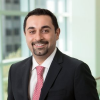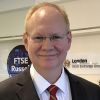The Managing Market Volatility 2019 Report, is a bespoke Report produced in collaboration with, and Sponsored by, FTSE Russell. Throughout the Report, we will explore alternative index approaches, minimum variance, low volatility factors, defensive multi-factor strategies and target exposure factors.
Clear path analysis
Menu1. EMEA ROUNDTABLE: How are defensive market strategies evolving today?
Traditional reallocation of capital during volatile markets has gradually evolved over the years. Part of this change has to do with the inclusion of broader asset classes in institutional portfolios. What are the ways that institutional investors are approaching volatility in the market, and the new strategies that they are employing to protect their portfolios?
Moderator:
- David Grana, Head of Production, Clear Path Analysis
Panellists:
- Mark Hedges, Chief Investment Officer, Nationwide Pension
- Jonathan White, Head of Client Portfolio Management, AXA Investment Management
- Mark Fitzgerald, Head of ETF Product Management, Europe, Vanguard
- Marlies van Boven, Managing Director, Research & Analytics, FTSE Russell
2. NORTH AMERICA ROUND TABLE: Despite the volatile market environment, when should institutional asset allocators make significant shifts to their investment strategies and based on what considerations?
In spite of monumental changes to financial markets over the last few decades, strategies of old are still very deep-rooted in institutional investors’ playbooks. Just like with many other preconceived strategies in financial markets, the current methods employed by investors to tackle market volatility simply isn’t working, and a paradigm shift is needed. What is this new and elusive strategy that can help investors protect their portfolio from sharp market movements during volatile times?
Moderator:
- David Grana, Head of Production, Clear Path Analysis
Panellists:
- Charles Van Vleet, Chief Investment Officer of Pension, Textron
- Chris Harvey, Head of Equity Strategy, Wells Fargo Securities
- Mo Haghbin, SVP, Global COO, Investment Solutions, Invesco
- Mark Barnes, Head of U.S. Research, FTSE Russell
3. THOUGHT PIECE: Market turmoil shows all defensive strategies are not the same.
Author: Mark Barnes, Managing Director, Head of U.S. Research, FTSE Russell
4. INTERVIEW: Is there a way to replicate active strategies through passive approaches and what are the implementation hurdles that must be overcome?
The active versus passive argument is overblown. Why can we find a happy medium? Is this what factor investing trying to teach? That you don’t need one strategy or the other, but that they can be executed in unison? And how is it that factor investing creates this happy balance between the two?
Interviewer:
- David Grana, Head of Production, Clear Path Analysis
Interviewee:
- Luke Oliver, Head of U.S. ETF Capital Markets, DWS

Mark Hedges
Chief Investment Officer, Nationwide Pension

Jonathan White
Head of Client Portfolio Management, AXA Investment Management

Mark Fitzgerald
Head of ETF Product Management, Europe, Vanguard

Marlies van Boven
Managing Director, Research & Analytics, FTSE Russell

Charles Van Vleet
Chief Investment Officer of Pension, Textron

Chris Harvey
Head of Equity Strategy, Wells Fargo Securities

Mo Haghbin
SVP, Global COO, Investment Solutions, Invesco

Mark Barnes
Head of U.S. Research, FTSE Russell

Luke Oliver
Head of U.S. ETF Capital Markets, DWS

David Grana
Head of Production, Clear Path Analysis

A leading global provider of benchmarks, analytics, and data solutions across asset classes
FTSE Russell is a leading global provider of benchmarks, analytics, and data solutions across asset classes. Our global perspective is underpinned by specialist knowledge gained from developing local benchmarks and understanding client needs around the world.
FTSE Russell index expertise and products are used extensively by institutional and retail investors globally. Approximately $16 trillion is currently benchmarked to FTSE Russell indexes. For over 30 years, leading asset owners, asset managers, ETF providers, and investment banks have chosen FTSE Russell indexes to benchmark their investment performance and create investment funds, ETFs, structured products and index-based derivatives. FTSE Russell also provides clients with data and analytics tools for asset allocation, investment strategy analysis, and risk management.
With the addition of The Yield Book business, FTSE Russell carries a highly respected analytics platform that is operating in its third decade and serves approximately 350 institutions globally including investment management firms, banks, central banks, insurance companies, pension funds, broker-dealers, hedge funds and investment management firms. The Yield Book’s products offer analytical insights into a broad array of fixed income instruments with specific focus on mortgage, government, corporate and derivative securities.
Through its Mergent business, a leading provider of business and financial information on public and private companies globally for over 100 years, FTSE Russell brings about a trusted partner to corporate and financial institutions, as well as to academic and public libraries. With advanced data collection services, cloud-based applications, desktop analytics and print products, Mergent provides solutions from top down economic and demographic information, to detailed equity and debt fundamental analysis.
FTSE Russell is wholly owned by London Stock Exchange Group.
For more information, visit ftserussell.com.
All our sponsorship packages are ‘tailor made’ to ensure complete success for our clients, so you can feel assured that your specific aims are being addressed. If you’re interested in any of the above benefits then please contact us below about sponsorship:
Call +44 (0) 207 1931 487 or send a message
By listening to those in the industry, we create a shortlist of individuals who most influence and inspire those around them and invite them to contribute to our reports and events by:
Contributing a thought piece on an issue raised in the market research
Participating in or moderating a roundtable with other industry leaders
Participating as an interviewer or interviewee
Producing a case study white paper written with a client or supplier
Taking part in a head to head debate with another respected industry professional.
Clear Path Analysis is always open to suggestions of suitable contributors for future topics.
Call +44 (0) 207 1931 487 or send a message
All our sponsorship packages are ‘tailor made’ to ensure complete success for our clients, so you can feel assured that your specific aims are being addressed. If you’re interested in any of the above benefits then please contact us below about sponsorship:
Call +44 (0) 207 1931 487 or send a message
All our sponsorship packages are ‘tailor made’ to ensure complete success for our clients, so you can feel assured that your specific aims are being addressed. If you’re interested in any of the above benefits then please contact us below about sponsorship:
Call +44 (0) 207 1931 487 or send a message
